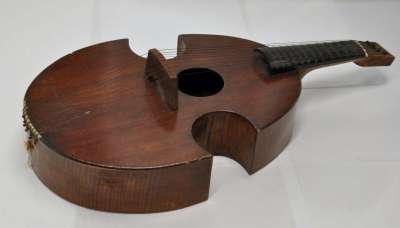String instrument
This cither is a hybrid between a viol and a guitar. Although the egg-shaped form of the body, with its cut out waist and round sound hole resembles a guitar, like a viol it would have been played with a bow. Sometimes referred to as a sultana, this instrument was brought out in the latter part of the eighteenth century by the Dublin violinmaker Thomas Perry.
Produced between 1764 and 1790, this example consists of a five pairs of wire strings, which were likely to have been originally tuned to G,C,E,G,C. Along the ebony fingerboard are twelve metal frets. At the end of the neck Preston’s improved tuning apparatus is attached; this was a common tool, popular in the 18th century, which enabled the strings to be tuned using a watch-key. The body is made from spruce, cedar and sycamore, the bridge from mahogany. We cannot be certain of the maker of the instrument, however it may have been created by a Mr Banks.
This cither was amongst a collection of instruments donated to RAMM by Mr Edward M Vinnicombe of Exeter, in 1876.
Produced between 1764 and 1790, this example consists of a five pairs of wire strings, which were likely to have been originally tuned to G,C,E,G,C. Along the ebony fingerboard are twelve metal frets. At the end of the neck Preston’s improved tuning apparatus is attached; this was a common tool, popular in the 18th century, which enabled the strings to be tuned using a watch-key. The body is made from spruce, cedar and sycamore, the bridge from mahogany. We cannot be certain of the maker of the instrument, however it may have been created by a Mr Banks.
This cither was amongst a collection of instruments donated to RAMM by Mr Edward M Vinnicombe of Exeter, in 1876.
Object Summary
- Accession Loan No.
- A765
- Collection Class
- Musical instruments
- Material
- ? spruce / cedar, sycamoremahoganyebonyebony and boxwoodmetal
- Common Name
- string instrument
- Simple Name
- musical instrument
- Period Classification
- George III (1760-1811)
- Production Town
- unk
- Production Country
- United Kingdom: England
- Production Person Surname
- ? Banks
- Production Year Low
- 1764
- Production Year High
- 1790


